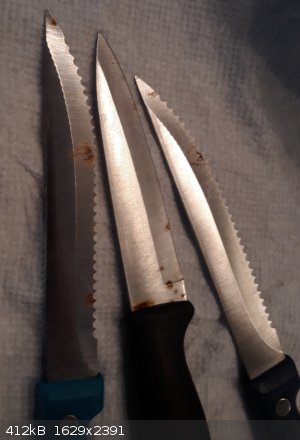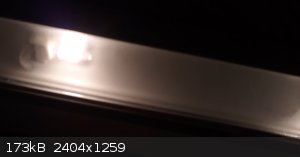AJKOER
Radically Dubious
    
Posts: 3026
Registered: 7-5-2011
Member Is Offline
Mood: No Mood
|
|
Stainless Steel Cutlery Corrosion By Aqueous Ascorbic Acid, Oxygen and Perhaps LED Illumination?!!
Apparently the combination food acids, in particular ascorbic acid, together with oxygen, moisture and a lighting fixture placed within 24 inches in
an overhead cabinet mounted with LED bulbs may had resulted, in part, in an electrochemical corrosion of the stainless steel (resulting in rust
formation and isolated pitting) of cutlery of varying ages. Of course, some may argue that this simply happens all the time to their knives.
I am assuming that given the diversity and age of the knives in question, my knives are NOT easily stain carbon steel, but more likely ‘High Carbon
Stain Free Steel’ composed of one of the more modern alloy metals, like chromium-Molybdenum Steel (see, for example, http://www.chefdepot.net/knifematerials.htm ).
Now, I suspect that the underlying process, which may have occurred over approximately 3 days, results from the presence of ascorbic acid (by ongoing
contact with a food particle, in this case, sticky mango juice and fruit pieces), oxygen, moisture (the knives were resting on a metal grid above the
sink) and new LED lamps. In essence, my take on what occurred is more complex involving some electrochemistry (explaining the duration before obvious
rusting was noticed) and perhaps also photo assisted corrosion resulting in staining and pit formations on the stainless steel cutlery.
My proposed take on the chemistry is as follows:
3 x [ Fe + ½ O2 + H+ --> Fe(2+) + OH- ] (an electrochemical reaction)
Then, a continuation of the chain starting with the ferrous:
Fe(+2) = Fe(+3) + e-
O2 + e- = O2•-
O2•- + H+ = HO2• (pKa = 4.88)
HO2• + Fe(+2) + H+ → Fe(+3)+ H2O2
Fe(+2) + H2O2 → Fe(+3) + OH• + OH-
---------------------------------------------
Net Reaction from ferrous: 3 Fe(2+) + O2 + 2 H+ --> 3 Fe(+3) + OH• + OH-
Net with Fe metal: 3 Fe + 5/2 O2 + 5 H+ → 3 Fe(+3) + OH• + 4 OH-
There is also a cited reference by Urbañski that apparently, Vitamin C is reported to continued the redox cycling for iron: Fe(+2) -> Fe(+3)
-> Fe(+2) thereby increasing the hydroxyl radical yield.
The alloy chromium may also have a role here, assuming it is electrochemically oxidized by O2 as well.
Comments by Wiki on Cr(VI), relating to the action of Vitamin C, to quote:
"Inside the cell, hexavalent chromium (chromium(VI)) is reduced first to pentavalent chromium (chromium(V)) then to trivalent chromium (chromium(III))
without the aid of any enzymes.[5][6] The reduction occurs via direct electron transfer primarily from ascorbate and some nonprotein thiols.[5]
Vitamin C and other reducing agents combine with chromate to give chromium(III) products inside the cell.[5] The resultant chromium(III) forms stable
complexes with nucleic acids and proteins.[5] "
Or, speculatively in the equilibrium formation of a redox couple with iron involving the regeneration of ferrous to support a redox cycle, as for
example:
Fe(3+) + Cr(2+) = Fe(2+) + Cr(3+)
Related comments (https://www.sciencemadness.org/whisper/viewthread.php?tid=80... ), albeit looking at iron/copper and not iron/chromium:
"The process is enhanced by contaminating Fe3+ and Cu2+", which is apparently repeated in the research literature, citing the apparent beneficial
impact of a mixed transition metal system which can introduce a coupled equilibria. In the same 2000 paper "Generation of .OH initiated by interaction
of Fe2+ and Cu+ with dioxygen; comparison with the Fenton chemistry" by Norbert K. Urbañski and Andrzej Berêsewicz, available at https://www.google.com/url?q=http://www.actabp.pl/pdf/4_2000... , the authors noted to quote "The Fe2+-mediated .OH yield was enhanced not only
by Fe3+ but also by Cu2+ (Fig.3)".
Lastly, I recently alluded to the ability of ferric acetate created in clouds in the presence of solar light to engage in a cyclical photo Fenton
reaction which may have been repeated here. Below is a description of a cyclic photo-Fenton–like system from a May 2019 article at https://advances.sciencemag.org/content/5/5/eaav7689 . To quote:
"The higher OH yield in the presence of UV light might be due to a photo-Fenton–like reaction (R4), where Fe(III) and organic ligands, such as
acetate, which is a product of the initial Fenton-like reaction (R3), form a complex leading to the reduction of Fe and the formation of an organic
radical that will form OH.
Fe(III) + CH3C(O)O− + hυ → Fe(II) + CH3C(O)O→OH radical formation (R4) "
----------------------------
Bottom line, stainless steel Cutlery or even perhaps stainless steel sink itself, may not fare well in the presence of certain select food acids,
especially from fruits, rich in Vitamin C, in the presence of oxygen, moisture and perhaps even some assistance from LED based Illumination, upon
standing over the course of several days. I would advise all to al least wash off fruit acid and other residue particles from your cutlery promptly
unless you don't mind some chemistry induced discoloration.
Pictures attached below.
[Edited on 10-8-2019 by AJKOER]
|
|
|
AJKOER
Radically Dubious
    
Posts: 3026
Registered: 7-5-2011
Member Is Offline
Mood: No Mood
|
|
Example of three displaying corrosion.

|
|
|
AJKOER
Radically Dubious
    
Posts: 3026
Registered: 7-5-2011
Member Is Offline
Mood: No Mood
|
|
One of many LED blubs.

|
|
|
AJKOER
Radically Dubious
    
Posts: 3026
Registered: 7-5-2011
Member Is Offline
Mood: No Mood
|
|
Front and back of the same knife.
 
|
|
|
Ubya
International Hazard
    
Posts: 1232
Registered: 23-11-2017
Location: Rome-Italy
Member Is Offline
Mood: I'm a maddo scientisto!!!
|
|
Maybe you should just wash your knives more often than once every three days. Plus, since when mango juice=ascorbic acid?
As always just speculation without any proof or test
(why ascorbic acid? Why not all the complex composition of fruit juice? Sugars? Enzymes? Salts? Naah let's stick to ascorbic acid because of reasons)
---------------------------------------------------------------------
feel free to correct my grammar, or any mistakes i make
---------------------------------------------------------------------
|
|
|
AJKOER
Radically Dubious
    
Posts: 3026
Registered: 7-5-2011
Member Is Offline
Mood: No Mood
|
|
Quote: Originally posted by Ubya  | Maybe you should just wash your knives more often than once every three days. Plus, since when mango juice=ascorbic acid?
As always just speculation without any proof or test
(why ascorbic acid? Why not all the complex composition of fruit juice? Sugars? Enzymes? Salts? Naah let's stick to ascorbic acid because of reasons)
|
Thanks for the quick review!
To quote a reference (https://www.quora.com/Which-acid-is-present-in-mango-juice):
"Mango juice is Rich in vitamin C, potassium, niacin and vitamin A"
I did not state the composition becomes in threads where I use Lemon Juice, I always mention the Ascorbic and Citric acid presence.
However, I should have not assumed everyone would accept the presence of Vitamin C.
Thanks also for mentioning salt, as any postulated electrochemistry needs a good electrolyte.
As to your other listed candidate agents, Vitamin C (and, as I cited previously on SM, Citric acid, see comments and sources at https://www.sciencemadness.org/whisper/viewthread.php?tid=80... ) has been clearly identified in the literature as impacting iron in redox
reactions (and also, as yet another source, see Eq(1) and Eq (2) at https://www.ncbi.nlm.nih.gov/pmc/articles/PMC6037948/ ).
Here is also a related 2000 paper "Generation of .OH initiated by interaction of Fe2+ and Cu+ with dioxygen; comparison with the Fenton chemistry" by
Norbert K. Urbañski and Andrzej Berêsewicz, available at https://www.google.com/url?q=http://www.actabp.pl/pdf/4_2000... .
[Edited on 10-8-2019 by AJKOER]
|
|
|
Ubya
International Hazard
    
Posts: 1232
Registered: 23-11-2017
Location: Rome-Italy
Member Is Offline
Mood: I'm a maddo scientisto!!!
|
|
mango has many insaturated fatty acids (check https://onlinelibrary.wiley.com/doi/abs/10.1111/j.1745-4514....) that are notorious antioxidants, they are the first compounds to get oxidized by
radical species, check https://www.sciencedirect.com/topics/food-science/unsaturate... if your speculation is partially right, you should have noticed a strong smell of
rancidity, have you? still is hard to say given the fact that those knives where dirty for 3 days, so maybe every fatty acid could have been oxidized
and the the metal has been corroded.
mango also is rich in carotenoids, that give the pulp its color (check https://images.app.goo.gl/xfhuZnmyJBqc5iwa7), carotenoids have an oxidation potential of 0.52-0.95V, clearly more of iron (Fe (0)-->Fe(II)+2e
0.44V) check
https://www.google.com/amp/s/www.researchgate.net/publicatio...
so clearly there are plenty of species capable of being oxidized way before any iron, and let's not forget sugars!
https://www.google.com/url?sa=t&source=web&rct=j&...
even ascorbic acid itself is oxidized by radicals.
LED light have a peak at 450nm, not enough to form any hydroxyl radicals, LED light emit pretty much 0 in the UV or near UV range
---------------------------------------------------------------------
feel free to correct my grammar, or any mistakes i make
---------------------------------------------------------------------
|
|
|
unionised
International Hazard
    
Posts: 5102
Registered: 1-11-2003
Location: UK
Member Is Offline
Mood: No Mood
|
|
What you have there looks like classic pitting corrosion.
https://www.substech.com/dokuwiki/doku.php?id=pitting_corros...
It has been known for a long time.
It has little to do with LEDs or ascorbic acid.
Any electrolyte- especially one that acts as a complexing agent will do.
The minerals and/ or citrate in mango juice would explain it without needing to resort to any weird chemistry.
Unlike your cutlery, Occam's razor doesn't go rusty.
|
|
|
AJKOER
Radically Dubious
    
Posts: 3026
Registered: 7-5-2011
Member Is Offline
Mood: No Mood
|
|
I actually found a reference on the kind of corrosion seen here on metal knives!
Please see https://www.knivesandtools.com/en/ct/rust-spots-on-kitchen-k... .To quote in part:
"I can see little specks of rust on my stainless steel kitchen knives. How is that possible? They are made from stainless steel and they were
absolutely not cheap either!
Answer of Knivesandtools:
These specks of rust are usually caused by pit corrosion. Pit corrosion is the most common type of corrosion in kitchen knives of stainless steel.
In hard knives with high carbon content, like knives of VG10 steel and the Twin Cermax knives, pit corrosion is most common. However, pit corrosion
also occurs in knives of ‘ordinary’ stainless knife steel.....
Background of pit corrosion
Stainless steel is steel that does not oxidise at air humidity up to 70%. That is achieved by adding approx. 15% chrome to the steel. The chrome forms
a thin layer of chrome oxide that closes off and protects the steel against corrosion by exposure to the air.
When the layer of chrome oxide is damaged, a new layer is normally formed. In itself nothing is happening then....It does become a problem if the
steel does not get the chance to form that new layer. That happens if the environment is moist (or wet). Small damage to the chrome oxide layer + a
water drop is the reason for pit corrosion. The result can be clearly seen on the picture. A small black fleck surrounded by a ring of rust.
Like we said the chrome oxide layer must first be damaged before pit corrosion occurs. That damage can have a mechanical cause (collision with
something hard) but a chemical too. Dish washing detergent food acids and contact with other types of steel can easily affect the chromoxide layer.
In the photo here water has extracted acid from the wooden handle and therefore the pit corrosion has started precisely on the transition from wood to
steel."
So my identification of pit corrosion was accurate. The agents listed in cited explanation (although not especially chemical oriented as air/oxygen
not explicitly referenced except in the broad context of pit corrosion) did included water and food acids, which I also noted.
For those unacquainted with the electrochemical nature of pit corrosion, this source https://www.sciencedirect.com/topics/chemistry/pitting-corro... notes:
"Pitting is most likely to occur in a halide ion containing media (mostly chloride) in the presence of oxygen or oxidizing agents."
So oxygen is very likely a factor here, as I claimed.
Also, while I did mention possible galvanic corrosion from the presence of different metals, I did NOT cite the precise source of the other metals,
which in the current case, would be other eating implements from diverse manufactures (referring to the spoons, forks,...) which, by physical contact,
could contribute to a galvanic current and superoxide formation as I detailed.
-----------------------------------
Unionised:
I just saw your comments, and you are right in your assertion (as am I) for 'classic pit corrosion'.
However, if your idea of 'weird chemistry' included my reference to possible effects of different metals releasing solvated electrons and reactive
oxygen species therefrom (I do confess, sounds a bit out there), well perhaps not far off after all. That is, assuming you accept the 'different
metals' contact argument above, than the other reactions, including some superoxide creation as an intermediate to a redox reaction seems plausible.
Further, my suggested chemical attack of the chromium metal (and implicitly its oxide) by O2 and Ascorbic acid, is actually more understated given the
author's frequent mention of the importance of Cr in thwarting pit corrosion.
So you may think about placing your 'Occam's razor' back in the box, as life/chemistry is not always as simple as we would perhaps want it to be.
[Edited on 11-8-2019 by AJKOER]
|
|
|
fusso
International Hazard
    
Posts: 1922
Registered: 23-6-2017
Location: 4 ∥ universes ahead of you
Member Is Offline
|
|
Why would you wash metal cutlery once every 3 days? And why don't you do control experiments with pure ascorbic acid?
|
|
|
unionised
International Hazard
    
Posts: 5102
Registered: 1-11-2003
Location: UK
Member Is Offline
Mood: No Mood
|
|
Ajkoer,
Do you know that it is possible to dissolve eggshells in vinegar without invoking a Fenton reaction?
|
|
|
Tsjerk
International Hazard
    
Posts: 3022
Registered: 20-4-2005
Location: Netherlands
Member Is Offline
Mood: Mood
|
|
Stainless steel just doesn't like acids, especially when there is e.g. chloride present. I got the same after dumping old orange juice in the sink
where also some cutlery was after forgetting that mess for a couple of days.
40% boiling NaOH? No problem... pH 3-4 with some electrolytes? Big mess.
|
|
|
AJKOER
Radically Dubious
    
Posts: 3026
Registered: 7-5-2011
Member Is Offline
Mood: No Mood
|
|
Quote: Originally posted by Tsjerk  | Stainless steel just doesn't like acids, especially when there is e.g. chloride present. I got the same after dumping old orange juice in the sink
where also some cutlery was after forgetting that mess for a couple of days.
40% boiling NaOH? No problem... pH 3-4 with some electrolytes? Big mess. |
Thanks for the comment and actually taking responsibility for now spotted cutlery.
I feel, on the other hand, but partially responsible as I do, only on occasion, help out in the kitchen and also regret not believing/expecting that
corrosion chemistry was occurring in my sink!
----------------------------------------------------
Interestingly, a mess in your sink is far less a problem than apparently adding both iron and Vitamin C to your diet, to quote:
"Conclusions. Co-supplementation of ferrous salts with vitamin C exacerbates oxidative stress in the gastrointestinal tract, predisposing individuals
to ulceration, inflammatory disorders, and exacerbation of existing chronic disorders and may cause cancer. Iron and ascorbic acid form a potentially
toxic cocktail."
Source: https://www.ncbi.nlm.nih.gov/pmc/articles/PMC340385/
----------------------------------------------------------------------------------------------
Pit corrosion is also disappointing for it does not really dissolve any significant amount of iron, just mostly disfigures it (but if it did, imagine
being 'armed' with just OJ, air, salt, and a lot of time, and being able to conceivably eat through iron bars  ). ).
[Edited on 11-8-2019 by AJKOER]
|
|
|
|